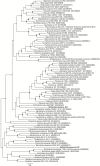Genomic Reconstruction of an Uncultured Hydrothermal Vent Gammaproteobacterial Methanotroph (Family Methylothermaceae) Indicates Multiple Adaptations to Oxygen Limitation
- PMID: 26779119
- PMCID: PMC4688376
- DOI: 10.3389/fmicb.2015.01425
Genomic Reconstruction of an Uncultured Hydrothermal Vent Gammaproteobacterial Methanotroph (Family Methylothermaceae) Indicates Multiple Adaptations to Oxygen Limitation
Abstract
Hydrothermal vents are an important contributor to marine biogeochemistry, producing large volumes of reduced fluids, gasses, and metals and housing unique, productive microbial and animal communities fueled by chemosynthesis. Methane is a common constituent of hydrothermal vent fluid and is frequently consumed at vent sites by methanotrophic bacteria that serve to control escape of this greenhouse gas into the atmosphere. Despite their ecological and geochemical importance, little is known about the ecophysiology of uncultured hydrothermal vent-associated methanotrophic bacteria. Using metagenomic binning techniques, we recovered and analyzed a near-complete genome from a novel gammaproteobacterial methanotroph (B42) associated with a white smoker chimney in the Southern Lau basin. B42 was the dominant methanotroph in the community, at ∼80x coverage, with only four others detected in the metagenome, all on low coverage contigs (7x-12x). Phylogenetic placement of B42 showed it is a member of the Methylothermaceae, a family currently represented by only one sequenced genome. Metabolic inferences based on the presence of known pathways in the genome showed that B42 possesses a branched respiratory chain with A- and B-family heme copper oxidases, cytochrome bd oxidase and a partial denitrification pathway. These genes could allow B42 to respire over a wide range of oxygen concentrations within the highly dynamic vent environment. Phylogenies of the denitrification genes revealed they are the result of separate horizontal gene transfer from other Proteobacteria and suggest that denitrification is a selective advantage in conditions where extremely low oxygen concentrations require all oxygen to be used for methane activation.
Keywords: Lau Basin; deep sea; denitrification; hydrothermal vent; methane; methane oxidation; nitrate; thermophile.
Figures






References
-
- Beaulieu S. E., Baker E. T., German C. R., Maffei A. (2013). An authoritative global database for active submarine hydrothermal vent fields. Geochem. Geophys. Geosyst. 14 4892–4905. 10.1002/2013GC004998 - DOI
Grants and funding
LinkOut - more resources
Full Text Sources
Other Literature Sources
Molecular Biology Databases

